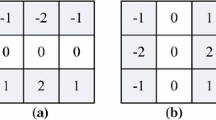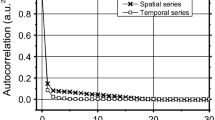Abstract
Purpose
Clinical procedures that make use of fluoroscopy may expose patients as well as the clinical staff (throughout their career) to non-negligible doses of radiation. The potential consequences of such exposures fall under two categories, namely stochastic (mostly cancer) and deterministic risks (skin injury). According to the “as low as reasonably achievable” principle, the radiation dose can be lowered only if the necessary image quality can be maintained.
Methods
Our work improves upon the existing patch-based denoising algorithms by utilizing a more sophisticated noise model to exploit non-local self-similarity better and this in turn improves the performance of low-rank approximation. The novelty of the proposed approach lies in its properly designed and parameterized noise model and the elimination of initial estimates. This reduces the computational cost significantly.
Results
The algorithm has been evaluated on 500 clinical images (7 patients, 20 sequences, 3 clinical sites), taken at ultra-low dose levels, i.e. 50% of the standard low dose level, during electrophysiology procedures. An average improvement in the contrast-to-noise ratio (CNR) by a factor of around 3.5 has been found. This is associated with an image quality achieved at around 12 (square of 3.5) times the ultra-low dose level. Qualitative evaluation by X-ray image quality experts suggests that the method produces denoised images that comply with the required image quality criteria.
Conclusion
The results are consistent with the number of patches used, and they demonstrate that it is possible to use motion estimation techniques and “recycle” photons from previous frames to improve the image quality of the current frame. Our results are comparable in terms of CNR to Video Block Matching 3D—a state-of-the-art denoising method. But qualitative analysis by experts confirms that the denoised ultra-low dose X-ray images obtained using our method are more realistic with respect to appearance.





Similar content being viewed by others
References
Albarqouni S, Baust M, Conjeti S, Al-Amoudi A, Navab N (2015) Multi-scale graph-based guided filter for de-noising cryo-electron tomographic data. In: BMVC, p 17-1
Amiot C, Girard C, Chanussot J, Pescatore J, Desvignes M (2016) Spatio-temporal multiscale denoising of fluoroscopic sequence. IEEE Trans Med Imaging 35(6):1565–1574
Boracchi G, Foi A (2008) Multiframe raw-data denoising based on block-matching and 3-d filtering for low-light imaging and stabilization. In: Proceedings of international workshop on local and non-local approximation in image processing, vol 1, pp 277–284
Buades A, Coll B, Morel JM (2005) A non-local algorithm for image denoising. In: Proceedings of IEEE computer society conference on computer vision and pattern recognition, vol 2, pp 60–65. IEEE
Cerciello T, Bifulco P, Cesarelli M, Fratini A (2012) A comparison of denoising methods for X-ray fluoroscopic images. Biomed Signal Process Control 7(6):550–559
Chaudhury KN, Singer A (2012) Non-local euclidean medians. IEEE Signal Process Lett 19(11):745–748
Chen Y, Pock T (2017) Trainable nonlinear reaction diffusion: a flexible framework for fast and effective image restoration. IEEE Trans Pattern Anal Mach Intell 39(6):1256–1272
Coupé P, Hellier P, Kervrann C, Barillot C (2009) Nonlocal means-based speckle filtering for ultrasound images. IEEE Trans Image Process 18(10):2221–2229
Dabov K, Foi A, Katkovnik V, Egiazarian K (2009) Bm3d image denoising with shape-adaptive principal component analysis. In: Signal processing with adaptive sparse structured representations
Fritz SL, Mirvis SE, Osher Pais S, Roys S (1988) Phantom evaluation of angiographer performance using low frame rate acquisition fluoroscopy. Med Phys 15(4):600–603
Goceri E, Goksel B, Elder JB, Puduvalli VK, Otero JJ, Gurcan MN (2017) Quantitative validation of anti-ptbp1 antibody for diagnostic neuropathology use: image analysis approach. Int J Numer Method Biomed Eng 33:e2862
Goodman T (2010) Ionizing radiation effects and their risk to humans. Image wisely radiation safety in adult medical imaging. Disponível na internet a 22
Guo Q, Zhang C, Zhang Y, Liu H (2016) An efficient SVD-based method for image denoising. IEEE Trans Circuits Syst Video Technol 26(5):868–880
Kostadin D, Alessandro F, KAREN E (2007) Video denoising by sparse 3d transform-domain collaborative filtering. In: European signal processing conference, vol 149
Lebrun M, Leclaire A (2012) An implementation and detailed analysis of the K-SVD image denoising algorithm. Image Process On Line 2:96–133
Lee MS, Park SW, Lee SY, Kang MG (2017) Motion-adaptive 3d nonlocal means filter based on stochastic distance for low-dose x-ray fluoroscopy. Biomed Signal Process Control 38:74–85
Lefkimmiatis S, Papandreou G, Maragos P (2008) Photon-limited image denoising by inference on multiscale models. In: Proceedings international conference on image processing, pp 2332–2335. IEEE
Luisier F, Blu T, Unser M (2010) Sure-let for orthonormal wavelet-domain video denoising. IEEE Trans Circuits Syst Video Technol 20(6):913–919
Makitalo M, Foi A (2013) Optimal inversion of the generalized Anscombe transformation for Poisson-Gaussian noise. IEEE Trans Image Process 22(1):91–103
Parker DL, Clayton PD, Tarbox LR, Von Behren PL (1983) Optimal dose utilization with variable X-ray intensity in digital radiography. In: Application of optical instrumentation in medicine XI, pp 102–110. International Society for Optics and Photonics
Schmidt U, Roth S (2014) Shrinkage fields for effective image restoration. In: Proceedings of IEEE computer society conference on computer vision and pattern recognition, pp 2774–2781
Wagner M, Yang P, Schafer S, Strother C, Mistretta C (2015) Noise reduction for curve-linear structures in real time fluoroscopy applications using directional binary masks. Med Phys 42(8):4645–4653
Weickert J, Scharr H (2002) A scheme for coherence-enhancing diffusion filtering with optimized rotation invariance. J Vis Commun Image Represent 13(1–2):103–118
Yang K, Huang SY, Packard NJ, Boone JM (2010) Noise variance analysis using a flat panel X-ray detector: a method for additive noise assessment with application to breast ct applications. Med Phys 37(7):3527–3537
Zhang K, Zuo W, Chen Y, Meng D, Zhang L (2017) Beyond a Gaussian denoiser: residual learning of deep cnn for image denoising. IEEE Trans Image Process 26:3142–3155
Acknowledgements
This work was supported by Siemens Healthcare GmbH. The concepts and results presented in this paper are based on research and not commercially available.
Author information
Authors and Affiliations
Corresponding author
Ethics declarations
Conflict of interest
The authors declare that they have no conflict of interest.
Ethical approval
All procedures performed in studies involving human participants were in accordance with the ethical standards of the institutional and/or national research committee and with the 1964 Helsinki declaration and its later amendments or comparable ethical standards. For this type of study formal consent is not required.
Rights and permissions
About this article
Cite this article
Hariharan, S.G., Strobel, N., Kaethner, C. et al. A photon recycling approach to the denoising of ultra-low dose X-ray sequences. Int J CARS 13, 847–854 (2018). https://doi.org/10.1007/s11548-018-1746-2
Received:
Accepted:
Published:
Issue Date:
DOI: https://doi.org/10.1007/s11548-018-1746-2




